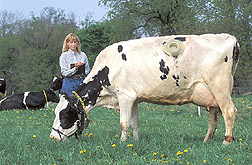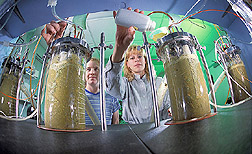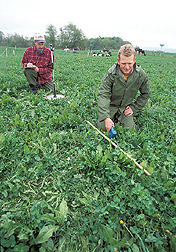Dairy Researchers Mix It Up in the Pasture |
|
 In studies of grazing efficiency and animal productivity on different pasture mixtures, animal scientist Kathy Soder observes the grazing behavior of a Holstein cow with a fistula on its side. The fistula allows scientists to sample partially digested samples from the animal's rumen. (K11047-14) |
Kathy Soder rests a hand on the Holstein cow. With the other, she removes the plug to the portal-like fistula that's surgically implanted into the animal's side. Gently tugging a pink string, she fishes out a series of small white bags from the cow's rumen, the largest compartment of its multichambered stomach. The procedure doesn't harm the cow, but it gives animal scientists like Soder unprecedented access to the animal's digestive system. Back at her Agricultural Research Service laboratory, located on the campus of Pennsylvania State University (PSU), Soder processes the bags so that the digested plant remains inside can be dried, weighed, and chemically analyzed. "I'm looking at how quickly and how much is digested by the cow," explains Soder, who is in ARS's Pasture Systems and Watershed Management Research Unit, University Park, Pennsylvania. "This gives us an idea of rumen availability—how much forage is broken down into products like amino acids that the animal can use." |
 In greenhouse studies to better understand how the number and kinds of forage species grown in pastures affect weed infestations, agronomist Matt Sanderson collects data on weed emergence in soil from nine pastures, each with a different plant species mixture. (K11048-3) |
Her four-legged subject is one of four fistulated cows in a herd of 20 Holsteins that are rotationally grazed on experimental pastures. The pastures contain mixtures of up to nine different species of cool-season grasses; legumes, such as clover; and forbs, like chicory. Soder's analysis of how efficiently the herd digests these forage plants is part of a larger study by a team of ARS and PSU scientists working at the college's Dairy Research Center. There, with the aid of the fistula and other research tools, the group aims to find out whether dairy farmers can boost milk production—or cut the costs of doing so—by seeding pastures with diverse blends of forage plants. "Farmers typically manage their pasture with one or two species, like a grass and a legume. We want to find out whether it would be better for them to plant more diverse species," says ARS agronomist Matt Sanderson. He and Soder are conducting the trials at the center with PSU professor Larry Muller and two University Park ARS colleagues, physiological plant ecologist Howard Skinner and plant ecologist Sarah Goslee. |
 Technician Melissa Goff (left) and animal scientist Kathy Soder analyze samples of the contents of a cow's rumen to determine speed and amount of digestion. (K11046-15) |
By design, their work coincides with growing interest in pasture-based dairy (PBD) systems as a lower cost, more sustainable alternative to confined feed operations. The trend seems especially popular among small or family-run dairy farms in the Northeast and parts of the Midwest, like Wisconsin, notes Soder. In Pennsylvania, she says, "10 to 15 percent of farmers are now grazing dairy cows to some degree." Pasture-based herds (those using a combination of pasture and supplementation) generally produce 10 percent less milk than herds in comparable confined feed operations, she adds. But a savvy PBD farmer, or "grazier," can increase profits from about $85 to $168 per cow annually through savings on time, labor, equipment, fuel, storage, and other expenses typically associated with confined operations. |
 To gauge how much time cows spend grazing in relation to forage intake, animal scientist Kathy Soder (left) and Pennsylvania State project assistant Julia Stack collect data from a special halter equipped with a computer chip that records grazing time and chewing. (K11045-13) |
The trend's popularity has outpaced the science a bit, and only recently have U.S. researchers taken a closer look at the potential benefits of diversifying the types of pasture plants that farmers normally grow. "The question we're trying to answer is: ‘Does increased biodiversity improve productivity, either of the pasture or the animal?’" says Sanderson. To that end, Sanderson, Skinner, and Goslee have established eight 2.5-acre pastures that contain different combinations of grasses, legumes, and forbs. The pastures include a control (a two-species mix of orchard grass and white clover) and three other mixtures of plant species from different "functional groups." These include a three-species mix of orchard grass and white clover plus chicory; a six-species mix of these three plus tall fescue, perennial ryegrass, and birdsfoot trefoil; and a nine-species mix of these six plus red clover, alfalfa, and Kentucky bluegrass. |
 Agronomist Keith Klement (left) and technician Dennis Genito collect data on botanical composition, forage yield, and nutritional value of experimental pastures and measure the distribution of forages at different levels of the pasture canopy. (K11049-7) |
Functional groups, Sanderson explains, are communities of plants that belong to different species but share common traits or functions within the same ecosystem. The relationships are mutually beneficial, such as that between grasses and legumes like alfalfa or clover, which fix atmospheric nitrogen into a chemical form that both species can use for growth. The plots' nine species are based on surveys of what northeastern dairy farmers use to seed their grazing lands. "We're using the same plants as the farmer," Sanderson says, "but our approach calls for more complex mixtures of these plants." Using various techniques, his group is collecting data on each pasture's botanical composition, crude protein content, photosynthesis rate, and yield of dry forage matter. In one approach, called stratification, they're measuring the concentration of forage species at different levels of the pasture canopy. The results show which species grazing cows are likely to encounter first and provide the researchers with data they can correlate to grazing behavior and preferences. "We're also studying the nutritional value of the plants as you go up and down the canopy," says Sanderson. Ultimately, the scientists want to know how such pasture-plant dynamics translate to animal productivity. "We're looking at milk yield and composition—specifically milk fat and protein," Soder explains. In 2002, Soder and Muller followed up on Sanderson's studies with the first round of grazing trials, which involved rotationally grazing 20 Holsteins on the pastures for four 21-day periods. As before, Sanderson's team monitored the pasture's botanical composition, forage quality, yield, and persistence. But this time, they did so before and after the animals had grazed the plots. During each grazing period, Soder and Muller kept close tabs on the herd's dry matter intake, digestive rates, milk production and quality, body weight, blood composition, rumen nutrient use, and other physiological markers. To gauge how much time and energy the cows spend grazing in relation to their forage intake, the scientists fitted special halters around each animal's head. A chin strap with a computer chip records 12 hours' worth of data on how many bites the cow takes as it grazes, as well as when and for how long. The device also differentiates such behavior from resting or cud chewing. "Grazing behavior can depend on factors such as pasture type, density, height, and availability," Soder explains, "and can be used to estimate grazing efficiency of the different pasture treatments in relation to productivity." In another technique, the scientists give the cows gel capsules of chromic oxide, a harmless substance that passes undigested through the animals. By taking a fecal specimen, the scientists can measure the substance's concentration and correlate that with the animal's intake of dry forage matter. On average, the trial's Holsteins each eat 90 to 100 pounds of "wet" forage, which translates to about 25 pounds of "dry" matter, that is, forage minus its water weight. From those 25 pounds of forage dry matter—plus a grain supplement—a cow produces 10 to 12 gallons of milk a day, Soder says. Her analysis of a cow's milk yield and composition also includes checking for conjugated linoleic acid (CLA), a fatty acid produced in the rumen and credited with anticarcinogenic properties. "We're monitoring this because research has shown that pastured dairy cows have higher levels of CLA in their milk than confined cows have," says Soder. In March 2003, Soder and Sanderson reported preliminary results from the 2002 trials at the Pennsylvania Grazing and Forage Conference held in Grantville, Pennsylvania. They noted, for example, that the total pounds of forage dry matter per acre for the 3-, 6-, and 9-species plots were 6,600, 7,000, and 6,700, respectively. That's compared to 4,300 pounds per acre for the 2-species plot used as a control. The fiber content of the pasture decreased as species diversity increased, a potential benefit. Despite these differences, "In general, milk production and composition were not affected by the level of forage diversity," Soder stated at the conference. For example, the average milk yield was 80 pounds (about 10 gallons) per cow per day, while the average fat content in the milk of cows on all four plots was 3.46 percent. "Not seeing a milk difference isn't necessarily a bad thing," says Soder. The main advantage the researchers expect from a multispecies pasture is a greater forage yield capable of sustaining more cows per acre than one with a single plant species. A highly productive pasture is also likely to cut the time and energy cows spend searching for edible forage. That, in turn, means more energy for producing milk. Soder and colleagues have begun a second round of grazing trials to confirm the 2002 results. As more findings emerge, the team plans to devise recommendations farmers can use to manage diverse pasture mixes for grazing. Soder adds, "The information gained from this experiment will also add to the limited data available on the intake and performance of high-producing grazing dairy cows in the United States, since much of current literature comes from other countries."—By Jan Suszkiw, Agricultural Research Service Information Staff. This research is part of Rangeland, Pasture, and Forages, an ARS National Program (#205) described on the World Wide Web at www.nps.ars.usda.gov. Kathy J. Soder and Matt A. Sanderson are in the USDA-ARS Pasture Systems and Watershed Management Research Unit, Bldg. 3702, Curtin Rd., University Park, PA 16802; phone (814) 865-3158 [Soder], (814) 865-1067 [Sanderson], fax (814) 863-0935. "Dairy Researchers Mix It Up in the Pasture" was published in the March 2004 issue of Agricultural Research magazine.
|






